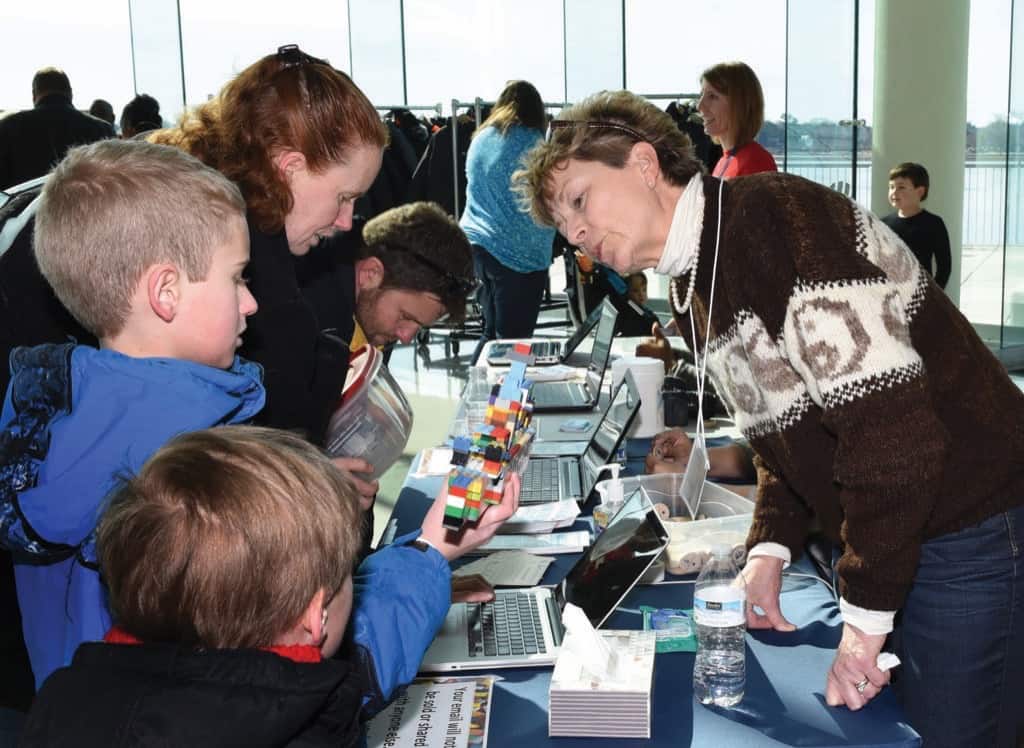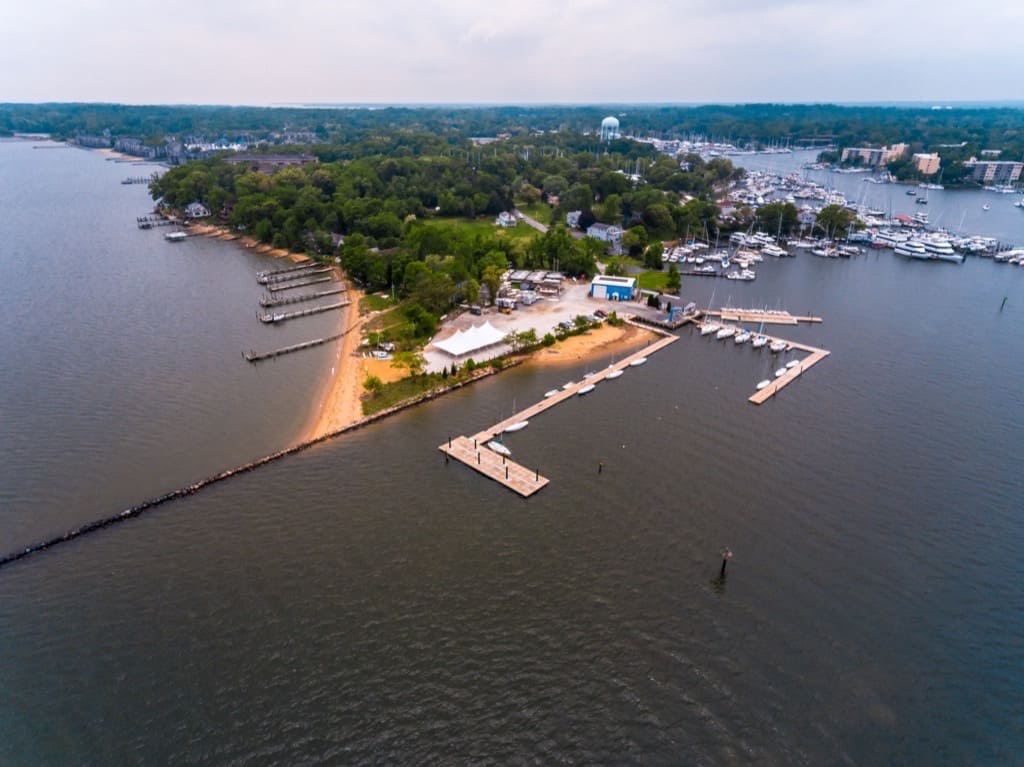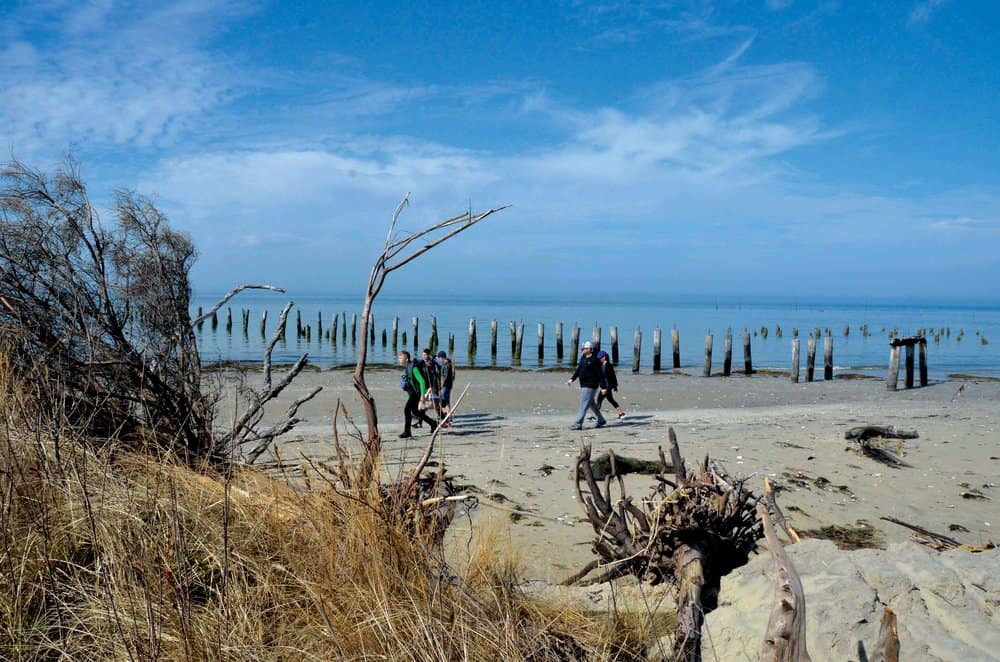Hampton Roads Naval Museum brings up the next generation of shipwrights
It’s a brisk but sunny February morning on the Norfolk waterfront, and shipbuilders are getting to it despite the nip in the air. From the mess deck to the turrets, pieces are adjusted here and blueprints are consulted there. The workers are poised to construct some of the finest vessels in the region.
It’s one shipbuilder’s first time on the job, and it’s becoming obvious that she needs assistance from a skilled hand. The young laborer casts a perplexed look my way. “Mom, can you help me with this piece?”
Fortunately for my little shipwright and the hundreds of other children at the 8th annual LEGO Brick by Brick Shipbuilding Event at the Decker Half Moone Cruise Terminal, there’s plenty of help to be had as they construct naval ships with what is arguably the world’s most beloved construction material. The event, conceived and hosted by the Hampton Roads Naval Museum, harnesses the power and popularity of LEGOs and STEM (Science, Technology, Engineering, and Math) to introduce the young and older to the Navy, its ships, and the museum.
An evergreen kid favorite, LEGO was an easy choice for a way to get folks of all ages connected to naval history and the museum.
“The museum wanted to do something fun to engage the community,” museum Director John Pentangelo says of the creation of the Brick by Brick event, which is presented in partnership with Nauticus, Norfolk’s maritime science center, and the Hampton Roads Naval Historical Foundation. And boy did it work. Eight hundred people showed up at the museum for the inaugural event, and the party picked up so much steam over the years that it’s been held on two floors of the adjacent Half Moone Cruise Terminal for the past two. More than 5,000 people packed the house for last year’s event.
Attendees can build 16 ships, enjoy a free-play area, and compete in a shipbuilding competition. There are also robotic demonstrations, crafts, and a sensory room for children with alternative needs. No matter the skill level, there’s a boat to build. Child and adult, military and civilian,
LEGO newbie or master builder, all are welcome.
But there’s more to it than just building cool stuff. The kids and the grownups who brought them there are receiving a naval education while they build. Here’s where the mission of the Hampton Roads Naval Museum comes into play. Pointing to the research, Pentangelo says only 16 percent of the public thinks the Navy is the most important branch of the armed forces. The museum wants to change that.
“We feel it’s very important to introduce people to the Navy, so by coming and building ships from the keel up, they start to get a naval vocabulary.” By playing with LEGOs, attendees learn about ships without even realizing they’re doing it, he says.
The event also offers a unique opportunity for the military and civilians to work together, since the majority of volunteers are enlisted Navy. It’s “literally bringing people in close contact with the men and women who serve,” explains Pentangelo.
Last year, the commanding officer of the Ticonderoga-class cruiser USS Gettysburg, Captain Corey Keniston, volunteered—something Pentangelo considers to be one of the highlights of his career. “He was helping children build his ship. That’s what we want to do.”
Keniston says the event is an opportunity to interact with the young builders and help them develop their skills and interests, all in the context of naval history, much of it local. After all, as he puts it, “maybe these are my next crew members!”
Situated on the second deck of the Nauticus building, the museum is smack dab in the middle of naval history past and future. The retired battleship USS Wisconsin is to one side, and the Norfolk Naval Shipyard is just across the Elizabeth River in Portsmouth. Not to mention the fact that Hampton Roads boasts the largest U.S. Navy fleet concentration as well as the world’s largest naval base, in Norfolk.
One of nine official Department of the Navy museums administered by the Naval Heritage and History Command in DC, the Hampton Roads Naval Museum has a simple mission.
“We do what all museums do,” explains Pentangelo. “We collect and preserve artifacts dealing with the role the Navy has played in the United States, but we engage our community.”
For Max Lonzanida, the museum’s public affairs officer, it’s impossible to point to just one reason why it’s worth a visit. It’s not just exhibits and artifacts, of which there are many. “Our educators venture to area public schools weekly to bring engaging educational programs without cost. We host lectures, staff outreach booths, publish a quarterly historical publication, provide guest speakers for events, assist with archival research and much more. So, in essence, what you see in our gallery is the tip of the iceberg,” Lonzanida explains.
The museum’s newest exhibit is The Ten Thousand-Day War at Sea: The U.S. Navy in Vietnam, 1950-1975, which is slated to be on display for the next three years. Nearly 5,000 square feet has been dedicated to telling the stories of local veterans who served in Vietnam.
Pentangelo says the exhibit focuses on the big question of “What did the Navy do?” during Vietnam. “We hope that by answering that question we can inform the public but also connect veterans to current service members, showing them that the things they do today are very similar to the things that were done
50 years ago.”
“Good history is about people,” he says, so the exhibit is centered on oral histories from more than 40 veterans in the Hampton Roads region. From treating the wounded as a corpsman, firing eight-inch guns off the coast of Vietnam, or working aboard a hospital ship, Pentangelo says that veteran accounts, presented through touch screen videos, will help visitors to gain an understanding of what sailors experienced during the war.
“We’re letting the veterans speak directly to the public, directly to the visitor. And that’s a very powerful thing that will hopefully help people understand what a multi-faceted war it was and the deep extent to which the Navy was involved,” he says.
Pentangelo estimates that more than 1.8 million sailors served during the conflict, and their stories need to be told. “They are our neighbors, and our citizens, our parents, grandparents, brothers, sisters, and they have not really been given a voice.” Now, thanks to the museum, they can be heard loud and clear.
From LEGO fun to naval history, senior sailor to small child, the Hampton Roads Naval Museum offers a reason for everyone to stop by and learn something new. As Lonzanida says of the museum and all those who make its mission a reality each day, “The dedication of our staff and volunteers; their creativity and drive to bring over 240 years of naval history to the public is what makes our museum one of the premier naval museums on the East Coast.”




